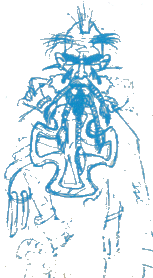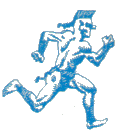Ever wanted to write a computer program? Does hex code and assembler make you see red? Well, perhaps all is not lost. Now it seems a new breed of writer has entered the arena equipped with nothing more than a set of Rotring pens and a handful of ideas. Lee Paddon talks to DAN MALONE, resident artist at Palace Software and learns why hex and machine code are still very much a mystery to Dan...

When Dan Malone left Ipswich College last year, possibly the thing furthest from his mind was writing a computer game. “I wanted to draw comic strips. I’d always admired magazines like 2000AD and the Marvel comics. So I went and pestered them, but there was nothing doing.
“Obviously it’s a very competitive line of work, and when you don’t have a track record, it’s hard to break in. I did do some work for Knock About Comics, which was sort of underground — they did things like Fat Freddy’s Cat, with Hunt Emerson who’s a well respected artist. But with them, it was a case of ‘oh we’ll pay you if we’ve got any money left over at the end of the month.’
“Going to Ipswich was a bit of a waste of time, but I suppose it did one thing — it gave me a portfolio of drawings to show around and one of the tutors was really helpful. In fact, she pointed out the advert in Campaign which lead to this job”.
That ad was placed by Pete Stone at Palace Software, and simply said ‘2000 AD style artist wanted — no previous experience with computers needed.’ “That was just as well, I’d never touched a home computer before. I’d seen a few machines in the arcades, but to me home computers meant little blobs flickering around a screen — I couldn’t think what a designer was meant to do there.”
But Dan rapidly discovered that things had moved on a bit since the early days, and was soon hard at work designing spites for Cauldron on the Amstrad, which was nearing completion at the time. This just involved using a sprite designer on the Commodore. “It was a pretty bad program. You could only draw in one colour at a time, so the only time you could see what the sprite was going to look like was when you had the program running. Pretty hopeless. For Antiriad, Stanley Schembri, one of Palace’s programmers, wrote a far better art utility which allows you to have the whole sprite on the screen and animate it.”
Meanwhile, the ideas for Antiriad were beginning to come together. Dan was given a few games to play to see what other people were doing and the sort of thing that might be possible. Cauldron and Sorcery were two games that caught his eye as examples of good graphics. Dan’s interest in 2000AD style comics led naturally to an arcade adventure style game with an overall quest. He wanted a mythical theme to the game with hi-tech overtones, and so the plot for a post-holocaust world where civilisation has come and gone began to evolve.

The first drawings Dan did were the movements for Tal, the Barbarian. Throwing rocks, crouching, running. After a while, screens started to come together. “Then we all sat round the office, bashing ideas around, so there’s a little bit of everyone in there. I suppose Stan actually started programming the Commodore version in July.”
Once the programmers got involved, the real battles started. Originally, the suit was going to consist of several pieces, but all this animation was really eating away at the available memory, so compromises had to be made: “There we’d be, lumbering in with these great big ideas that were totally impossible, but then again, it really pushed the programmers to try and come up with ways of doing things.”
But there were positive contributions as well. The programmers came up with the notion of ‘ressing in’ and out of the suit — the flashing combination of Tal and Suit when he gets in and out of it — and things like the teleport. But the programmers didn’t take over, Dan was still very much involved. “We had a program where I could alter backgrounds and then test them. If I thought a screen was too easy I could move a sprite a little, and then try it out again. I could move the position of meanies and the way they moved.”
“The game’s playability came about by trial and error. You design a route through the game and then stick in lots of red herrings. But obviously it is completely impossible to gauge whether you’ve succeeded, so it was a profound relief when the Press started to look at the preview versions and liked what they saw. I remember we took round a preview version on the Commodore to Tim Metcalfe at C&VG. He looked at it, and decided he’d seen enough and wrote the first review. It was then that we really knew we were on the home stretch”.
Having lived with it for so long, the story of the world of Antiriad started to evolve, and so came the idea for the comic which comes with the game, drawn by Dan. He has evolved a whole life history for each meanie: “Most of them are just mutants left over from the war which ended civilisation. There was another race on the planet which collaborated with the aliens when they invaded. So, for being so nice, the aliens enslaved them and turned them into cyborgs, part man, part machine. You’ll meet them in the city blazing away with rather nasty machine guns. Mutated dragons in the volcano section have been paralysed, but their jaws still work, and as they move their jaws, sparks are generated, which light the gas seeping up through the vents, sending a sheet of flame across the cavern.”
Well, after the Amstrad version has been polished off, it’ll be back to the drawing board for Dan. So now you know how it’s done. All you need is a few good ideas, a talent for drawing, a team of tame programmers and the odd year of late nights and you too can be a programmer. So what are you waiting for?